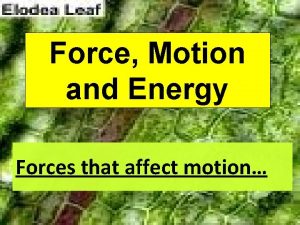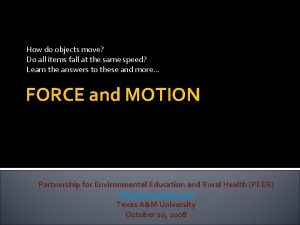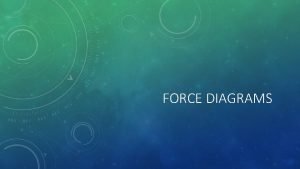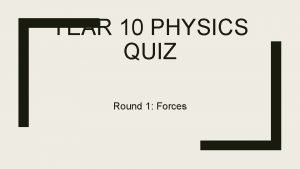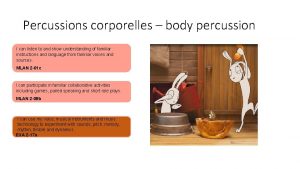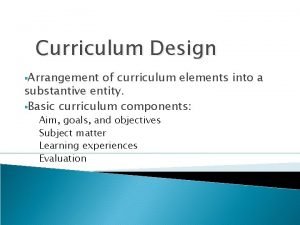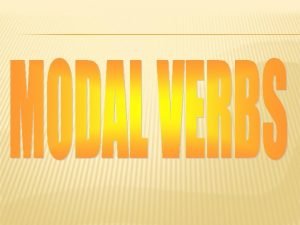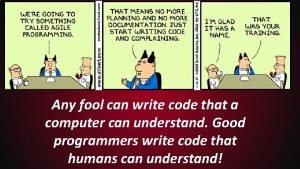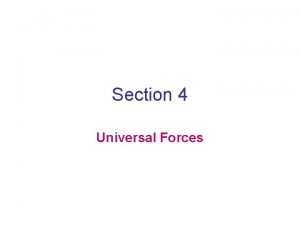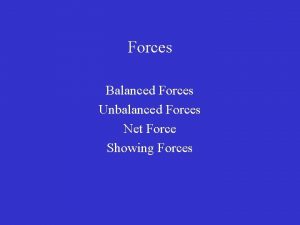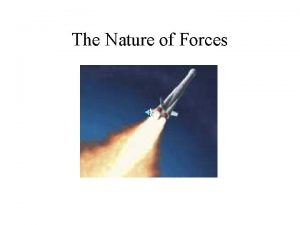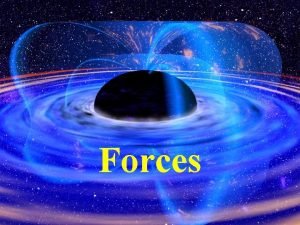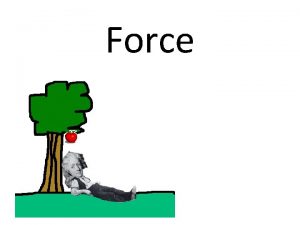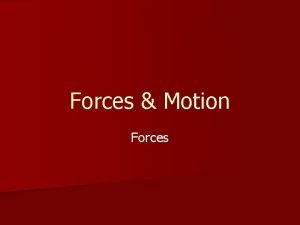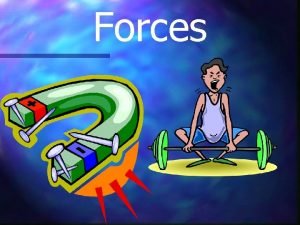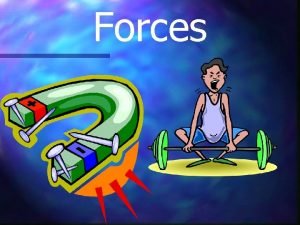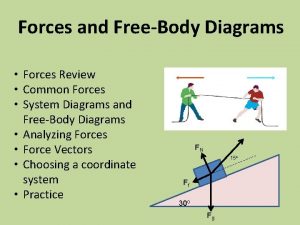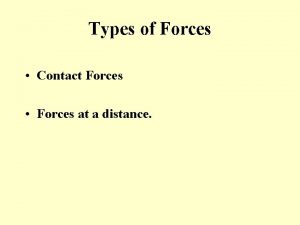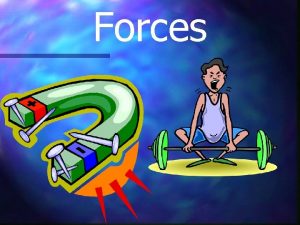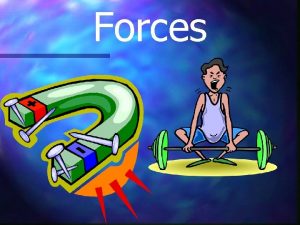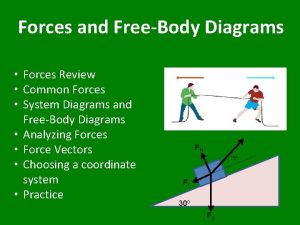Forces What is a force A force can
































- Slides: 32

Forces

What is a force? • A force can be defined as a push or pull on something. • A tow truck pulls a car by applying a force on it. • The force of gravity causes a fly ball in a baseball game to return to earth by pulling downward on the ball.

• There are four fundamental forces in nature. The four forces are as follows: • Gravitational Force • Electromagnetic Force • Weak Nuclear Force • Strong Nuclear Force • These forces are fundamental because all the other forces that are encountered in nature can be shown to be different aspects of these four forces.

• In the middle part of the sixteen hundreds and first part of the seventeen hundreds lived a man viewed now by many as the greatest scientist of all time. • Isaac Newton was a mathematician, philosopher, and probably the first true physicist. • Using the work of Galileo and Kepler, Newton formulated his three laws of motion and the law of universal gravitation.

The Law of Inertia • Newton's first law states that an object tends to maintain a constant velocity until acted on by a net force. • This is sometimes call the law of inertia.

Example • If we slide an object across the floor it eventually stops. • If we lubricate the surfaces of the floor and the object then it will continue in a straight line for a greater amount of time before it comes to rest. • If we keep making the two surfaces slicker and slicker then the object, once set in motion, will continue in a straight path for a greater and greater distance. • If we can remove all the forces that resist the motion the object will continue to move in a straight line forever.

Newton's Second Law • Newton's second law states that when a net force acts on an object the acceleration of that object as a result of the force is directly proportional to the net force and has a magnitude that is inversely proportional to the mass.

Newton's Second Law • Mathematically stated: Or

• In the previous equation "a" is acceleration, "F" is the applied force, and "m" is the mass of the object. • In SI the unit force is the Newton "N". • Note the net force is the vector sum of all the forces on a mass.

Example • Two people are pushing on a stalled car. • The mass of the car is 1850 kg. • One person applies a force of 275 N to the car, while the other person pushes with a force of 395 N. • Both forces act in the positive x direction. • A third force due to friction from the cars tires and the road opposes the push of the two people and has a magnitude of 560 N. • What is the acceleration of the car?

Solution

Solution cont. • The acceleration can now be obtained by dividing the net force by the mass:

Newtons’ Third Law • Newton's third law of motion states that whenever one object exerts a force on a second object, the second object exerts an oppositely directed force of equal magnitude on the first body. • Newton's third law tells us that all forces come in pairs. • There is no such thing as an isolated force acting all by itself. The third law is sometimes known as the law of action - reaction.

Example: • Suppose that the mass of a spacecraft is ms = 11000 kg and the mass of an astronaut is m. A = 92 kg. • If the astronaut is outside of the spacecraft and she exerts a force of 36 N on the spacecraft then what will be the accelerations of the spacecraft and the astronaut?

Solution • The acceleration of the spacecraft is:

Solution • The acceleration of the astronaut is:

Example • Two people push on a stuck vehicle. • If each person applies a force of 700 N in the positive x direction and the retarding force of the vehicle plus the force supplied by the tires is 950 N, determine the acceleration of the vehicle. • The mass of the vehicle is 2000 kg.

Free-Body Diagram -950 N 2000 kg 700 N

Solution • According to Newton’s second law the acceleration of the vehicle is:

Example • Two people engaged in an argument begin to fight. • One person pushes against the other with a force of 250. 0 N. • If the people are standing on a very slick surface, determine the magnitude of the acceleration of each person if their masses are 45. 0 kg and 55. 0 kg.

Free-Body Diagram -250 N 45 kg 55 kg 250 N

Solution • According to Newton’s third law the forces must be of equal magnitude and opposite direction. • From Newton’s second law we get:

Example • A person is dragging a trunk containing a dead body, up an incline with a slope of 15 o. • The rope that pulls the crate makes an angle of 25 o with respect to the incline. • What force must the person exert on the rope if she is to just pull the trunk up the hill. • Assume the weight is Fcrate = 200 N, on the crate.

Free-Body Diagram • We first draw a picture labeling the forces. 25 o 15 o

Solution • We place the x-axis along the incline for convince. • Note: we are assuming that there is no friction between the trunk and the incline.

Solution cont. • We break the forces up into components and set them equal to zero since there is no acceleration.

Solution cont. • The magnitude of the force is then:

Solution cont. • The x and y components are:

Solution cont. • The force is then:

Example • Determine the magnitude of the normal force exerted on the crate by the incline plane in the previous example.

Solution • The sum of the forces on the crate in the ydirection was:

• Now that we know the applied force we can determine the normal force on the crate.
 Examples of like parallel forces
Examples of like parallel forces The forces shown above are pushing/pulling forces
The forces shown above are pushing/pulling forces Intramolecular vs intermolecular bonds
Intramolecular vs intermolecular bonds Intra vs intermolecular
Intra vs intermolecular Covalent bond intermolecular forces
Covalent bond intermolecular forces What are some contact forces and some noncontact forces
What are some contact forces and some noncontact forces Force examples in everyday life
Force examples in everyday life Destructive process examples
Destructive process examples Photo of forces that affect motion in plants
Photo of forces that affect motion in plants What can forces do to objects
What can forces do to objects Body diagram
Body diagram Which of the following forces is a contact force? *
Which of the following forces is a contact force? * If you can imagine it you can achieve it
If you can imagine it you can achieve it You can tell harris about it just ____(easily) as i can
You can tell harris about it just ____(easily) as i can If you think you can you can poem
If you think you can you can poem If you can't measure it
If you can't measure it If you cant measure it you can't manage it
If you cant measure it you can't manage it Percussions corporelles
Percussions corporelles The arrangement of elements of curriculum is
The arrangement of elements of curriculum is You can tell harris about it just ____(easily) as i can.
You can tell harris about it just ____(easily) as i can. Comparative and superlative for less
Comparative and superlative for less I cant but he can
I cant but he can Look at the pictures and complete with can or can't
Look at the pictures and complete with can or can't Bear hunt song dr jean
Bear hunt song dr jean Through you i can do anything
Through you i can do anything You cant manage what you cant measure
You cant manage what you cant measure Talk en futuro
Talk en futuro Any fool can write code that a computer can understand
Any fool can write code that a computer can understand Should i compare thee
Should i compare thee Investitionsanalyse kennzahlen
Investitionsanalyse kennzahlen Modal verbs inability
Modal verbs inability What universal force can repel as well as attract
What universal force can repel as well as attract Coplanar concurrent forces examples
Coplanar concurrent forces examples








